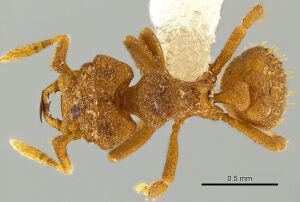Rhopalothrix triumphalis
| Rhopalothrix triumphalis | |
|---|---|

| |
| Scientific classification | |
| Kingdom: | Animalia |
| Phylum: | Arthropoda |
| Class: | Insecta |
| Order: | Hymenoptera |
| Family: | Formicidae |
| Subfamily: | Myrmicinae |
| Tribe: | Attini |
| Genus: | Rhopalothrix |
| Species: | R. triumphalis |
| Binomial name | |
| Rhopalothrix triumphalis Longino & Boudinot, 2013 | |
This species occurs in cloud forest habitats, from 1360–2140 m elevation. All specimens are from Winkler or Berlese samples of sifted leaf litter. It is sympatric with Rhopalothrix megisthmica on the slopes of Volcán Tacaná in Chiapas. At the type locality it was moderately abundant, occurring in 17 of 100 miniWinkler samples. (Longino and Boudinot 2013)
Identification
Anterior labral lobe bilobed, with lateral lobule longer than medial lobule; masticatory margin of mandible with two teeth; squamiform setae of first gastral tergite abundant, elongate, 4 × or 5 × longer than wide; HW 0.57–0.65. (Longino and Boudinot 2013)
Keys including this Species
Distribution
Mexico (Chiapas).
Latitudinal Distribution Pattern
Latitudinal Range: 18.5859972° to 15.7084456°.
| North Temperate |
North Subtropical |
Tropical | South Subtropical |
South Temperate |
- Source: AntMaps
Distribution based on Regional Taxon Lists
Neotropical Region: Mexico (type locality).
Distribution based on AntMaps
Distribution based on AntWeb specimens
Check data from AntWeb
Countries Occupied
| Number of countries occupied by this species based on AntWiki Regional Taxon Lists. In general, fewer countries occupied indicates a narrower range, while more countries indicates a more widespread species. |

|
Estimated Abundance
| Relative abundance based on number of AntMaps records per species (this species within the purple bar). Fewer records (to the left) indicates a less abundant/encountered species while more records (to the right) indicates more abundant/encountered species. |

|
Biology
Rhopalothrix triumphalis, Rhopalothrix atitlanica, and Rhopalothrix andersoni share a distinctive labrum shape with bilobed anterolateral margin, with the lateral lobule longer and more triangular than the medial lobule. The three form a geographic replacement series, with no known zones of sympatry.
|
Castes
Males have yet to be collected.
Worker
Images from AntWeb
     
| |
| Holotype Rhopalothrix triumphalis. Worker. Specimen code casent0602067. Photographer Brendon Boudinot, uploaded by University of Utah. | Owned by CAS. |
 
| |
| Paratype Rhopalothrix triumphalis. Worker. Specimen code casent0601887. Photographer Erin Prado, uploaded by California Academy of Sciences. | Owned by MCZC. |
Nomenclature
The following information is derived from Barry Bolton's Online Catalogue of the Ants of the World.
- triumphalis. Rhopalothrix triumphalis Longino & Boudinot, 2013: 319, figs. 1A, 2B, 3F, 14, 16 (w.q.) MEXICO.
Unless otherwise noted the text for the remainder of this section is reported from the publication that includes the original description.
Description
Worker
HW 0.57–0.65 (n=12); mandible with two teeth on masticatory margin, second tooth from base largest; subapical tooth with minute reclinate denticle at base; subapical tooth about twice as long as apical tooth; intercalary teeth prominent, one closest to apical tooth about half as long as apical tooth; labrum trapezoidal, anterior margin bilobed, lateral lobule triangular, longer than medial lobule, medial lobules rounded, flanking semicircular median notch; arcuate promesonotal groove and metanotal groove moderately impressed; propodeal tooth variable, obtuse, right angled, or acute, infradental lamella evenly and shallowly concave; squamiform setae abundant on first gastral tergite, uniformly covering entire tergite; gastral setae relatively long and thin, 4–5 × longer than wide, with elongate stem below widened apex.
Queen
HW 0.69; mandible and labrum similar to worker; face shape similar to worker but with less strongly developed grooves and ridges; compound eye longer than maximum width of scape; ocelli small, cuticle adjacent to ocelli marked with black pigment spots on evenly light brown background; shape of propodeal tooth, infradental lamella, petiole and postpetiole similar to worker; katepisternum and anepisternum large, convex, separated by broad U-shaped groove; layer of sparse, long, appressed pubescence covers mandible, face, scapes, legs, dorsal mesosoma and metasoma; abundant stiff erect setae on face, anterior edge of scape, side of head, dorsal mesosoma, dorsal gaster.
Type Material
Holotype, worker: Mexico, Chiapas: 2.8 km ESE Custepec, 15.72078 -92.93925 ± 50 m, 1800 m, 17 Jul 2007, mixed hardwood forest, ex sifted leaf litter (R.S. Anderson#2007-017) California Academy of Sciences, unique specimen identifier CASENT0602067. Paratypes (workers): same data as holotype but 18 Jul 2007, liquidambar forest (R.S. Anderson#2007-018) Colección Entomológica de El Colegio de la Frontera Sur, CASENT0601766; 1.8 km SE Custepec, 15.72198 -92.95037 ± 50 m, 1530 m, mixed liquidambar forest (R.S. Anderson#2007-020) Museum of Comparative Zoology, CASENT0601887]; 2 km SE Custepec, 15.72298 -92.94493 ± 50 m, 1650 m, ridgetop oak forest (R.S. Anderson#2007-021) National Museum of Natural History, CASENT0601965; 2.8 km SE Custepec, 15.72260 -92.93995 ± 50 m, 1840 m, oak forest (R.S. Anderson#2007-022) Universidad Nacional Autonoma de Mexico, CASENT0603013.
Etymology
Referring to the type locality, El Triunfo Biosphere Reserve in the Sierra Madre de Chiapas.
References
- Longino J. T. and Boudinot B. E. 2013. New species of Central American Rhopalothrix Mayr, 1870 (Hymenoptera, Formicidae). Zootaxa. 3616:301-324. doi:10.11646/zootaxa.3616.4.1
References based on Global Ant Biodiversity Informatics
- Dattilo W. et al. 2019. MEXICO ANTS: incidence and abundance along the Nearctic-Neotropical interface. Ecology https://doi.org/10.1002/ecy.2944
- Longino J. T., and B. E. Boudinot. 2013. New species of Central American Rhopalothrix Mayr, 1870 (Hymenoptera, Formicidae). Zootaxa 3616: 301-324.
- Longino J. et al. ADMAC project. Accessed on March 24th 2017 at https://sites.google.com/site/admacsite/


